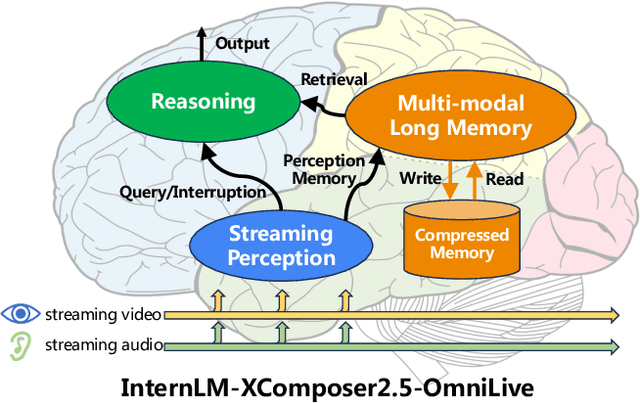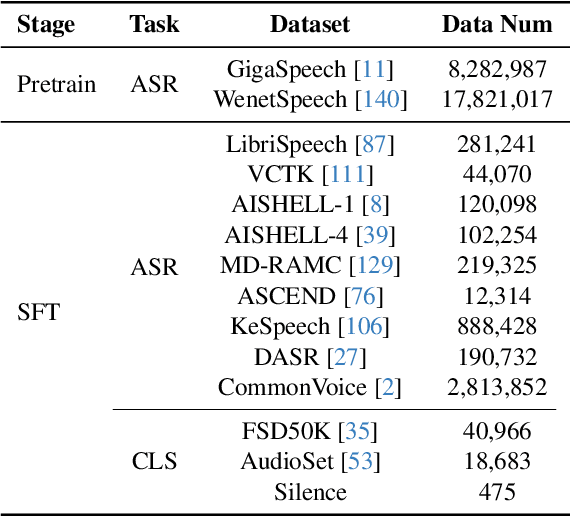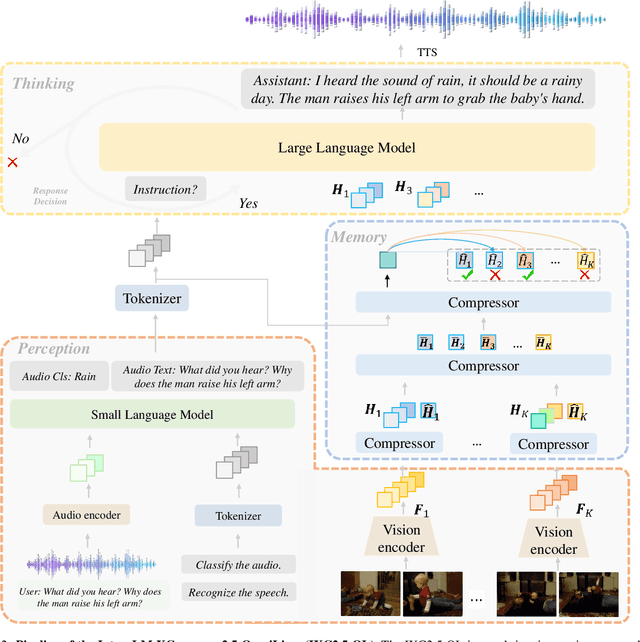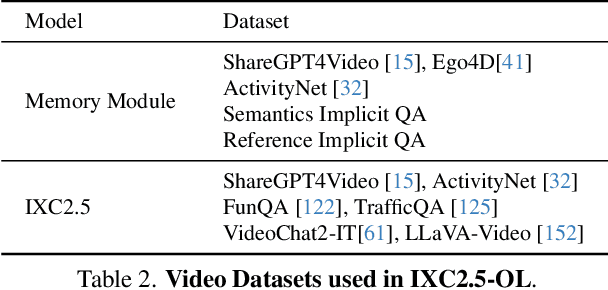Xilin Wei
VideoRoPE: What Makes for Good Video Rotary Position Embedding?
Feb 07, 2025Abstract:While Rotary Position Embedding (RoPE) and its variants are widely adopted for their long-context capabilities, the extension of the 1D RoPE to video, with its complex spatio-temporal structure, remains an open challenge. This work first introduces a comprehensive analysis that identifies four key characteristics essential for the effective adaptation of RoPE to video, which have not been fully considered in prior work. As part of our analysis, we introduce a challenging V-NIAH-D (Visual Needle-In-A-Haystack with Distractors) task, which adds periodic distractors into V-NIAH. The V-NIAH-D task demonstrates that previous RoPE variants, lacking appropriate temporal dimension allocation, are easily misled by distractors. Based on our analysis, we introduce \textbf{VideoRoPE}, with a \textit{3D structure} designed to preserve spatio-temporal relationships. VideoRoPE features \textit{low-frequency temporal allocation} to mitigate periodic oscillations, a \textit{diagonal layout} to maintain spatial symmetry, and \textit{adjustable temporal spacing} to decouple temporal and spatial indexing. VideoRoPE consistently surpasses previous RoPE variants, across diverse downstream tasks such as long video retrieval, video understanding, and video hallucination. Our code will be available at \href{https://github.com/Wiselnn570/VideoRoPE}{https://github.com/Wiselnn570/VideoRoPE}.
InternLM-XComposer2.5-OmniLive: A Comprehensive Multimodal System for Long-term Streaming Video and Audio Interactions
Dec 12, 2024



Abstract:Creating AI systems that can interact with environments over long periods, similar to human cognition, has been a longstanding research goal. Recent advancements in multimodal large language models (MLLMs) have made significant strides in open-world understanding. However, the challenge of continuous and simultaneous streaming perception, memory, and reasoning remains largely unexplored. Current MLLMs are constrained by their sequence-to-sequence architecture, which limits their ability to process inputs and generate responses simultaneously, akin to being unable to think while perceiving. Furthermore, relying on long contexts to store historical data is impractical for long-term interactions, as retaining all information becomes costly and inefficient. Therefore, rather than relying on a single foundation model to perform all functions, this project draws inspiration from the concept of the Specialized Generalist AI and introduces disentangled streaming perception, reasoning, and memory mechanisms, enabling real-time interaction with streaming video and audio input. The proposed framework InternLM-XComposer2.5-OmniLive (IXC2.5-OL) consists of three key modules: (1) Streaming Perception Module: Processes multimodal information in real-time, storing key details in memory and triggering reasoning in response to user queries. (2) Multi-modal Long Memory Module: Integrates short-term and long-term memory, compressing short-term memories into long-term ones for efficient retrieval and improved accuracy. (3) Reasoning Module: Responds to queries and executes reasoning tasks, coordinating with the perception and memory modules. This project simulates human-like cognition, enabling multimodal large language models to provide continuous and adaptive service over time.
MMDU: A Multi-Turn Multi-Image Dialog Understanding Benchmark and Instruction-Tuning Dataset for LVLMs
Jun 17, 2024Abstract:Generating natural and meaningful responses to communicate with multi-modal human inputs is a fundamental capability of Large Vision-Language Models(LVLMs). While current open-source LVLMs demonstrate promising performance in simplified scenarios such as single-turn single-image input, they fall short in real-world conversation scenarios such as following instructions in a long context history with multi-turn and multi-images. Existing LVLM benchmarks primarily focus on single-choice questions or short-form responses, which do not adequately assess the capabilities of LVLMs in real-world human-AI interaction applications. Therefore, we introduce MMDU, a comprehensive benchmark, and MMDU-45k, a large-scale instruction tuning dataset, designed to evaluate and improve LVLMs' abilities in multi-turn and multi-image conversations. We employ the clustering algorithm to ffnd the relevant images and textual descriptions from the open-source Wikipedia and construct the question-answer pairs by human annotators with the assistance of the GPT-4o model. MMDU has a maximum of 18k image+text tokens, 20 images, and 27 turns, which is at least 5x longer than previous benchmarks and poses challenges to current LVLMs. Our in-depth analysis of 15 representative LVLMs using MMDU reveals that open-source LVLMs lag behind closed-source counterparts due to limited conversational instruction tuning data. We demonstrate that ffne-tuning open-source LVLMs on MMDU-45k signiffcantly address this gap, generating longer and more accurate conversations, and improving scores on MMDU and existing benchmarks (MMStar: +1.1%, MathVista: +1.5%, ChartQA:+1.2%). Our contributions pave the way for bridging the gap between current LVLM models and real-world application demands. This project is available at https://github.com/Liuziyu77/MMDU.
ShareGPT4Video: Improving Video Understanding and Generation with Better Captions
Jun 06, 2024



Abstract:We present the ShareGPT4Video series, aiming to facilitate the video understanding of large video-language models (LVLMs) and the video generation of text-to-video models (T2VMs) via dense and precise captions. The series comprises: 1) ShareGPT4Video, 40K GPT4V annotated dense captions of videos with various lengths and sources, developed through carefully designed data filtering and annotating strategy. 2) ShareCaptioner-Video, an efficient and capable captioning model for arbitrary videos, with 4.8M high-quality aesthetic videos annotated by it. 3) ShareGPT4Video-8B, a simple yet superb LVLM that reached SOTA performance on three advancing video benchmarks. To achieve this, taking aside the non-scalable costly human annotators, we find using GPT4V to caption video with a naive multi-frame or frame-concatenation input strategy leads to less detailed and sometimes temporal-confused results. We argue the challenge of designing a high-quality video captioning strategy lies in three aspects: 1) Inter-frame precise temporal change understanding. 2) Intra-frame detailed content description. 3) Frame-number scalability for arbitrary-length videos. To this end, we meticulously designed a differential video captioning strategy, which is stable, scalable, and efficient for generating captions for videos with arbitrary resolution, aspect ratios, and length. Based on it, we construct ShareGPT4Video, which contains 40K high-quality videos spanning a wide range of categories, and the resulting captions encompass rich world knowledge, object attributes, camera movements, and crucially, detailed and precise temporal descriptions of events. Based on ShareGPT4Video, we further develop ShareCaptioner-Video, a superior captioner capable of efficiently generating high-quality captions for arbitrary videos...
InternLM-XComposer2: Mastering Free-form Text-Image Composition and Comprehension in Vision-Language Large Model
Jan 29, 2024Abstract:We introduce InternLM-XComposer2, a cutting-edge vision-language model excelling in free-form text-image composition and comprehension. This model goes beyond conventional vision-language understanding, adeptly crafting interleaved text-image content from diverse inputs like outlines, detailed textual specifications, and reference images, enabling highly customizable content creation. InternLM-XComposer2 proposes a Partial LoRA (PLoRA) approach that applies additional LoRA parameters exclusively to image tokens to preserve the integrity of pre-trained language knowledge, striking a balance between precise vision understanding and text composition with literary talent. Experimental results demonstrate the superiority of InternLM-XComposer2 based on InternLM2-7B in producing high-quality long-text multi-modal content and its exceptional vision-language understanding performance across various benchmarks, where it not only significantly outperforms existing multimodal models but also matches or even surpasses GPT-4V and Gemini Pro in certain assessments. This highlights its remarkable proficiency in the realm of multimodal understanding. The InternLM-XComposer2 model series with 7B parameters are publicly available at https://github.com/InternLM/InternLM-XComposer.
Evaluating and Improving Tool-Augmented Computation-Intensive Math Reasoning
Jun 04, 2023Abstract:Chain-of-thought prompting~(CoT) and tool augmentation have been validated in recent work as effective practices for improving large language models~(LLMs) to perform step-by-step reasoning on complex math-related tasks. However, most existing math reasoning datasets may be not able to fully evaluate and analyze the ability of LLMs in manipulating tools and performing reasoning, as they may only require very few invocations of tools or miss annotations for evaluating intermediate reasoning steps. To address the issue, we construct \textbf{CARP}, a new Chinese dataset consisting of 4,886 computation-intensive algebra problems with formulated annotations on intermediate steps. In CARP, we test four LLMs with CoT prompting, and find that they are all prone to make mistakes at the early steps of the solution, leading to wrong answers. Based on this finding, we propose a new approach that can deliberate the reasoning steps with tool interfaces, namely \textbf{DELI}. In DELI, we first initialize a step-by-step solution based on retrieved exemplars, then iterate two deliberation procedures that check and refine the intermediate steps of the generated solution, from the perspectives of tool manipulation and natural language reasoning, until obtaining converged solutions or reaching the maximum turn. Experimental results on CARP and six other datasets show that the proposed DELI mostly outperforms competitive baselines, and can further boost the performance of existing CoT methods. Our data and code are available in \url{https://github.com/RUCAIBox/CARP}.
 Add to Chrome
Add to Chrome Add to Firefox
Add to Firefox Add to Edge
Add to Edge